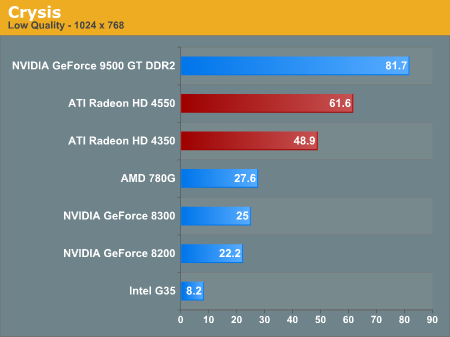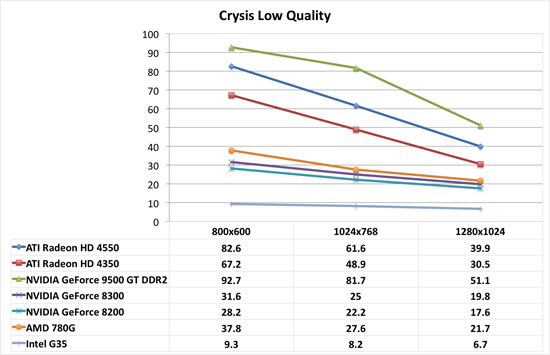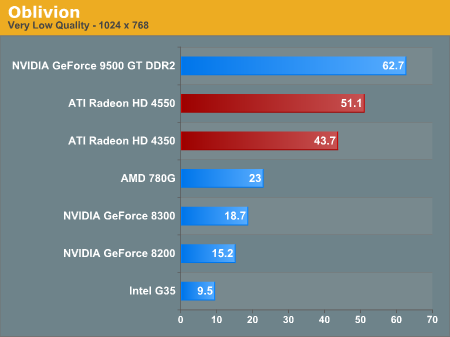ATI Radeon HD 4350 and 4550: Great HTPC Solutions
by Derek Wilson on September 30, 2008 12:45 AM EST- Posted in
- GPUs
The Benefits Over Integrated Graphics
For our comparison to integrated graphics, we looked at two games: Crysis and Oblivion. These games tend to cover the spectrum fairly well from DX9 to DX10, and they tell the same story: integrated graphics suck.
First up is Crysis. For integrated graphics, we needed to test everything at the absolute lowest setting, and even that was painful. It is too bad we couldn't test 640x480, as that might have given some of this hardware a chance at playability. But with the tests we did run, none of our integrated solutions were really playable at 1024x768, and only the AMD 780G did anything useful at 800x600. By contrast, the 4350 and the 4550 both we very playable at this very low quality setting. Pushing up to 1280x1024 wasn't really as effective, but the 4550 did still hang on to playable framerates at that resolution.


As for Oblivion, we see nearly the same behavior as with Crysis. There is a huge performance gap between integrated graphics and even the lowest end of add-in cards we are testing today. And these settings with Oblivion are insanely ugly. We would never recommend playing with very low settings ever. It's a horrendous experience.


As usual, Intel's integrated graphics are the biggest joke of the bunch. But that's not any sort of feather in AMD or NVIDIA's cap here: Intel's G35 is just really horrible hardware for 3D.
So, with the benefit over integrated graphics well established, how do these parts compare to the slightly higher price bracket right next door? Let's take a look at how they compare to NVIDIA's 9500 GT DDR2 and AMD's 4670.










55 Comments
View All Comments
haplo602 - Tuesday, September 30, 2008 - link
So you are testing 2 cards aimed mainly on HTPC market but all you do is GAME benchmarks ?What about a video playback test compared to the best IGP solutions ? I mean CPU offload graphs and such ?
deruberhanyok - Tuesday, September 30, 2008 - link
I agree. The article calls them "Great HTPC Solutions" but how does the article apply to an HTPC? You run a few games with a ridiculously high end processor and motherboard but spend a page talking about 8 channel PCM output and that's how you call it a great HTPC solution?How about testing with a low speed processor and micro ATX motherboard more likely to be found in an HTPC? How about using those quieter, cooler components to run a CPU usage test so we can see how well the video decode works? Why not test on a 780G motherboard and show us if hybrid crossfire works with the current drivers?
Why not compare the card's video decode capabilities against the current line of IGPs? If you have a motherboard with an IGP that can competently accelerate high definition video then the question becomes "is it worth the $40-$50 for one of these over your current card-less solution?"
If someone is interested in one of these cards for an HTPC, how well it runs Crysis when paired with a quad core Core 2 Extreme is not a remotely important question.
What kind of rationale made this article make any kind of sense?
deruberhanyok - Tuesday, September 30, 2008 - link
And now that I look at it again I wonder how you compared these cards to onboard video such as the 780G.Do you have a 780G board that can run that quad core Core 2 Extreme processor so we could see an actual comparison? Maybe you ran them with a Phenom X4 sitting at around 3.5GHz so the numbers would be reasonably close to those put up by the Core 2 Extreme.
7Enigma - Tuesday, September 30, 2008 - link
I actually went back through the review assuming I had double-clicked or something and bypassed the practical comparisons that actually MATTER with these cards. I'm shocked there is nothing. I routinuely stick up for the articles here, but this one is really poor.Strid - Tuesday, September 30, 2008 - link
Yeah, I agree. That is pretty important for the point the author is trying to prove. Also, the cards seem pretty power hungry? It's difficult to tell from the charts, but they're pretty close to the 4670 and 9500GT? I would have liked to see power ratings for only the 4550/4350. Sure they blow the hat off IGPs, no question, but at what power cost?Manabu - Tuesday, September 30, 2008 - link
Acording to AMD, they use less than 20W at full load. The 4670 should use less than 60W. Also note that the PSU ineficiency afects the charts.Calin - Tuesday, September 30, 2008 - link
This was the system power - measured from the wall. Unfortunately, the power used by video card is difficult to measure (if at all possible without a big budget). Some guesses on the power use would be fine, though, and some temperature readings tooBigLan - Tuesday, September 30, 2008 - link
Can either of these run in hybrid crossfire on a 780g or 790gx motherboard, or does only the 3450 work?These cards sound really nice for converting an older box into a htpc, though I'm not sure if lpcm audioo out is such a big deal at this price point - you're going to need a relatively expensive receiver to take advantage of it, so the $30 difference between a 4550 and 4650 isn't going to really matter, though the passive cooler might.
hiphile - Wednesday, November 25, 2009 - link
I'm testing two of the MSI 1GB DDR3 R4550 cards, running on Windows 7 Ultimate x64 and they are are running in Crossfire mode, no additional power is required other than plugging it into the PCI-E slots. The performance is decent, but I think I would opt for the 4850 cards.Calin - Tuesday, September 30, 2008 - link
The 4550 will also has reduced power requirements over the 4650 - and this will help with the noise level too.